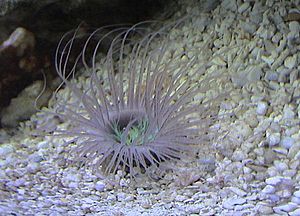Tube-dwelling anemone facts for kids
Quick facts for kids Tube-dwelling anemones |
|
|---|---|
 |
|
| Cerianthus sp. | |
| Scientific classification |
|
| Kingdom: | Animalia |
| Phylum: | Cnidaria |
| Class: | Anthozoa |
| Subclass: | Ceriantharia |
| Subgroups | |
Tube-dwelling anemones, also known as ceriantharians, look a lot like regular sea anemones. But they are actually quite different! They belong to their own special group of animals called anthozoans. These creatures live all by themselves, buried in soft sand or mud at the bottom of the ocean.
Tube anemones build amazing homes. They live inside tubes made from a special, strong material. This material is created from their own sticky slime (mucus) and tiny threads. These threads come from special stinging cells called ptychocysts. What's really cool is that sometimes more than one tube anemone can live in the same tube system. This is unusual because most animals that build tubes only have one creature per tube.
Tube-dwelling anemones used to be grouped with black corals. But scientists later realized they were unique. So, they were given their very own group, called Ceriantharia.
Contents
What Makes Them Special?
Tube anemones have a crown of tentacles. These tentacles are arranged in two circles. The tentacles in the outer circle are large and spread outwards. They are pointed and are mostly used to catch food and protect the anemone from danger.
The smaller tentacles are in the inner circle. They stand up straighter than the outer ones. These smaller tentacles are used to move food towards the anemone's mouth. They also help the anemone eat its meals.
Floating Anemones
Most tube anemones stay attached to the ocean floor. But a few types, like Anactinia pelagica, are different. They are called pelagic species. This means they float freely in the water.
These floating anemones have a special gas bubble inside their body. This bubble helps them float upside down near the water's surface. It's like having their own built-in life jacket!
Family Tree: How They're Grouped
Scientists group living things into different categories. This helps us understand how they are related. Tube-dwelling anemones are divided into two main groups, called orders. Within these orders, there are smaller groups called families.
Order Spirularia
- Family Botrucnidiferidae
- Family Cerianthidae
Order Penicillaria
- Family Arachnactidae
Scientists are always learning new things. A study in 2020 looked closely at tube anemones. It used information from their genes and how they look. This study showed that the Arachnactidae family is a clear group. However, it suggested that the Cerianthidae and Botrucnidiferidae families might need more study. This means scientists are still working to understand the exact family tree of these amazing creatures!
See also
 In Spanish: Ceriántidos para niños
In Spanish: Ceriántidos para niños

